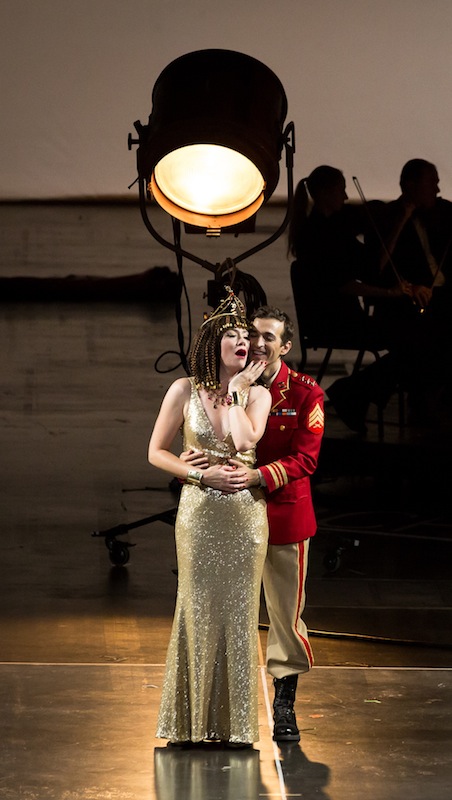Resilience Theater proves an ideal space for HGO’s silver-screen “Caesar”

Heidi Stober as Cleopatra and Anthony Roth Costanzo in the title role of Handel’s “Julius Caesar” at Houston Grand Opera. Photo: Lynn Lane
Stage director James Robinson has transplanted Handel’s tale of the emperor and Cleopatra to a 1930s movie studio, where a costume epic is in the works. And if you’re hoping to conjure up a Hollywood sound stage–capacious, bristling with lights and rigging, functional rather than fancy–the temporary theater in the George R. Brown Convention Center fills the bill ideally.
During the overture, cast and crew members scurry across the stage, signing in and setting up. Before the opening ensemble begins, a sign emblazoned “Quiet on the Set” lights up. Caesar, a Nelson Eddy type in a red military uniform, enters atop a tank–which, as the audience sees later, is just an empty shell made as a prop.
Cleopatra is a platinum-blonde bombshell, and she works her wiles on Caesar in a scene that pays homage to Hollywood legend Busby Berkeley. Cleopatra spins out her seductive aria “V’adoro, pupille” surrounded by a handful of supernumeraries who waft around her in the spirit–if not the numbers–of Berkeley’s battalions of dancers.
By melding the ancient characters’ heroics and glamor with Hollywood-style transformations thereof, Robinson is just following Handel’s lead. After all, the Baroque icon capitalized on the tale of Caesar and Cleopatra to showcase yet another brand of heroics and glamor–the vocal kind.
Julius Caesar is essentially a string of arias. The principals get several turns apiece in the spotlight, and those set them up with abundant opportunities to show off their virtuosity, poetry and finesse.
At the opening-night performance on Friday, the principals treaded carefully as they began. Countertenor Anthony Roth Costanzo, making his HGO debut, sang Caesar’s entrance aria in a light, whitish tone that hardly suggested an emperor returning victoriously from war. But as he and the rest of the principals limbered up their voices, Handel’s score began stirring to life.
When Caesar mused on the slain warrior Pompey’s fleeting glory, Costanzo’s voice grew more and more disembodied–the musical equivalent of dust turning to dust. In the aria “Va tacito,” showing Caesar steeling his resolve to punish Pompey’s killer, Costanzo’s buoyancy and crispness brought out the music’s vigor–and the horn solos by the HGO Orchestra’s Spencer Park added a swagger of their own.
As Caesar revved up for battle in Act 3, Costanzo delivered his “Quel torrente” with a vibrancy and agility that the entrance aria had hardly suggested. He also threw himself into Robinson’s Hollywood flourishes: When Cleopatra’s spell over Caesar first took hold, Costanzo did a few soft-shoe steps as he sang. But as the battlefield called and Caesar brandished his rifle, Costanzo’s habit of wriggling his torso while singing coloratura kept him from cutting as heroic a figure as he might.
There may not be an exact vocal parallel to platinum blonde, but soprano Heidi Stober’s mix of silvery gleam and a tinge of warmth came close. The sleekness and lilt she gave “V’adoro, pupille” projected the temptress’s allure beyond the footlights. And the surges of fervor Stober lavished on the serious moments–such as Act 3’s “Piangerò”–showed that Cleopatra had a heart.
Countertenor David Daniels, who portrayed Caesar when Robinson’s production premiered in 2003, returned to HGO as Cleopatra’s brother Ptolemy, killer of Pompey. Daniels brought Handel’s music vigor and color, and he also engaged unabashedly in the Hollywood hijinks: In a scene between the siblings, played out in Cleopatra’s dressing room, Daniels’ Ptolemy bore out her claims that he was a fop by trying on her necklace–and beaming with satisfaction.
The counterbalance to such frivolity came from mezzo-soprano Stephanie Blythe, who played Cornelia, Pompey’s widow. Thanks to Blythe’s weighty tone and dignified phrasing, Cornelia’s laments exuded eloquence. And when Ptolemy made an unwelcome advance on Cornelia, the sheer punch of Blythe’s voice put him in his place.
The opera’s third countertenor role, that of Cleopatra’s confidant Nirenus, brought the HGO debut of Aryeh Nussbaum Cohen, a new member of the HGO Studio training program. Cohen, a winner of last spring’s Metropolitan Opera National Council Auditions, brought his aria a freshness and flair that made him worthy of his spot amid his more-celebrated fellow countertenors.
Bass-baritone Federico De Michelis, a recent alumnus of the Studio program, sang resonantly as Ptolemy’s henchman Achillas. But another Studio alum, mezzo-soprano Megan Mikailovna Samarin, sounded out of her element as Sextus, Pompey’s son and avenger. Samarin tossed off some vivacious phrases as Sextus’ vengeance drew nigh. But she had the cast’s smallest voice, and projecting into the Resilience Theater was more than she could consistently do.
The theater, set up quickly in an exhibit hall after Hurricane Harvey put HGO’s home out of commision, is a godsend for the company. But most voices face a challenge to make an impact.
My vantage point Friday was about halfway up the bleacher-style seats that comprise most of the theater’s capacity. Robinson had helped the singers as much as he could by putting the action near the edge of the stage. Blythe, whose voice booms even in New York’s cavernous Metropolitan Opera, had no trouble asserting herself. Stober’s brightness helped her Cleopatra cut through.
The rest of the voices were audible, but had little presence; sometimes it took concentration to tune in to them. The singers’ effort to be heard may have contributed to some smudgy runs and trills amid Handel’s vocal acrobatics.
But for a converted exhibit hall, the wonder may be that the acoustics are as good as they are. Though they helped the HGO Orchestra no more than they did the singers, the musicians–onstage behind the action, led by Patrick Summers–played with crispness and zip. And concertmaster Denise Tarrant, put in costume and thrust onstage next to Costanzo, added sprightly violin solos to one of Caesar’s salutes to his loved one.